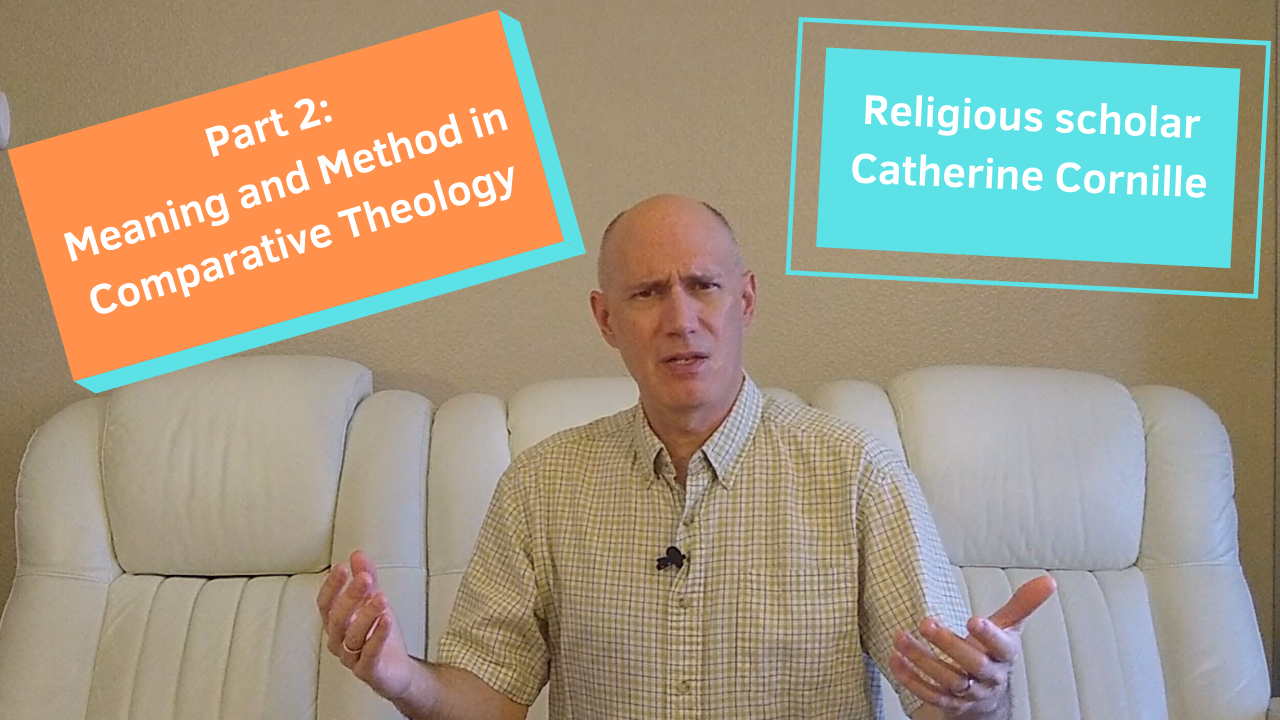01/13/2021 Meaning and Method in Comparative Theology

Comparative theology? Seriously? Catherine who? This is TenOnReligion.
Hey peeps, it’s Dr. B. with TenOnReligion. This is the second of a two-part series on a religious scholar from Boston College named Catherine Cornille each focusing on one of her books. The last episode looked at her 2008 book, The im-Possiblity of Interreligious Dialogue, and this episode we’ll look at her more recent book, Meaning and Method in Comparative Theology from 2020.
Comparative theology is a little bit of a misnomer because it’s not really talking about theology proper (although it can be that), but it’s more focused on how we can understand religions different from our own. Cornille’s book has five chapters and we’ll briefly summarize each one, but first just a quick background note. The contemporary comparative theology movement started in the 1990’s largely with Francis Clooney (he goes by Frank) who began at Boston College and is now at Harvard University and James Fredericks, from Loyola Marymount University in Los Angeles. Both are Roman Catholic leaders with Clooney being an expert in Hinduism and Fredericks an expert in Buddhism. Now Cornille’s book portrays many aspects of this movement. It is very objective and straightforward. She is almost entirely descriptive and does not really takes sides in any of the positions she explains, which can be either a good or a bad thing, depending on how you look at it.
So let’s start with chapter 1 of Cornille’s book. She talks about two main types of comparative theology: confessional and meta-confessional. Confessional comparative theology happens within a specific religion. The basic process is that a person investigates something or someone that is related to their own religion in another religion, like prayer in Judaism vs. meditation in Buddhism, or like Jesus’ mother Mary in the New Testament gospels vs. Mary in the Qur’an. Through the effort of this investigation like reading texts, studying history, or learning new interpretations, one can deepen, enrich, or even critique the teachings or practices of one’s own religion. Meta-confessional comparative theology is a similar process, but without the constraints of a particular religious tradition. It is more transreligious, with the possibility of identifying with more than one religion to begin with.
In chapter 2, Cornille lays out the land, so to speak, of five common categories which have been used for many decades in the academic field of religion. The first is exclusivism which often results in an apologetical attitude towards other religions. The second is particularism, which focuses on the perspectival nature of religion. This is drawn largely from the work of George Lindbeck and Mark Heim. The third is inclusivism in two parts: closed and open. In general, inclusivism is the idea that one’s tradition is true and all others are to some degree “on the way” towards my tradition. Closed inclusivism emphasizes the fullness of truth of one’s home tradition, represented by Karl Rahner and Gavin D’Costa. Open inclusivism only emphasizes the central teachings of the home tradition as a minimal norm. The main figure highlighted here is Jacques Dupuis. The fourth category Cornille mentions is pluralism, where there are some neutral or common criteria to judge other religions. This can be found in the work of John Hick, Paul Knitter, or more recently, Perry Schmidt-Leukal. Lastly, post-colonialism is the idea of critiquing power relationships in understanding religion, such as identity vs. diversity and the problem of essentializing religion. Who gets to say what “Hinduism” is or who “owns” Christianity? Things like that.
The third chapter is about hermeneutics. Do we learn about the other through the self by recognizing our own prejudices? Do we learn about the self through the other by way of sympathy and imagination? One can learn about another tradition by participation in such activities as artistic expressions, religious rituals, or reading other scriptures. The issue in these endeavors, however, is that there are always language issues with interreligious borrowing. Two problems occur: syncretism – where incompatible ideas are mixed, often without regard to consistency or coherence with the home tradition, and hegemony – where uneven power dynamics can often surface without one even realizing it. This can unintentionally generate a lack of respect or humility towards others – a problem most of us have unfortunately been on the receiving end of at some point in our lives. [hit me again!]
In the fourth chapter, Cornille mentions six types of learning in comparative theology. Comparative theology can be used to intensify one’s own religion. It can rectify one’s own tradition by correcting a misunderstanding. It can recover a formerly neglected or forgotten teaching or practice. It can reinterpret some aspect of religion. It can cause one to appropriate religious symbols to fit a new religious context. And lastly, it can reaffirm a particular understanding.
In the fifth and final chapter, Cornille unpacks a lot of concerns that comparative theology has for traditional, or confessional theology. The reason behind this is because when one starts to really study and become interested in certain aspects of other religions, it can challenge one’s home tradition. Where is the source for understanding religion? Is it solely internal to one’s own tradition, or can it occasionally be external? Who is the audience for comparative theology? Individuals? Groups? Which groups? Does comparative theology create tension? Is it intimidating to learn a new view about a familiar topic, or does it represent an opportunity to expand one’s interpretive framework? Cornille suggests that the short history of contemporary comparative theology since it emerged in the 1990’s indicates that it is not always predictable or controllable. Studying other religions for the purpose of enhancing one’s own often takes one down roads and paths that are unexpected to say the least.
So what do you think? Take a person, topic, ritual, or practice in your own religion and say that something similar exists in another religion. If you were to study that person, topic or ritual in another religion how do you think that would affect your own view? Do you think your interpretation would change based on the other religion’s perspective? Why or why not? What does that say about how we understand what role religion plays in our lives? Cornille’s book certainly raises interesting questions to think about.
I hope this vlog has helped you better understand this topic. Until next time, stay curious. If you enjoyed this, please like this video and subscribe to the channel. This is TenOnReligion.


